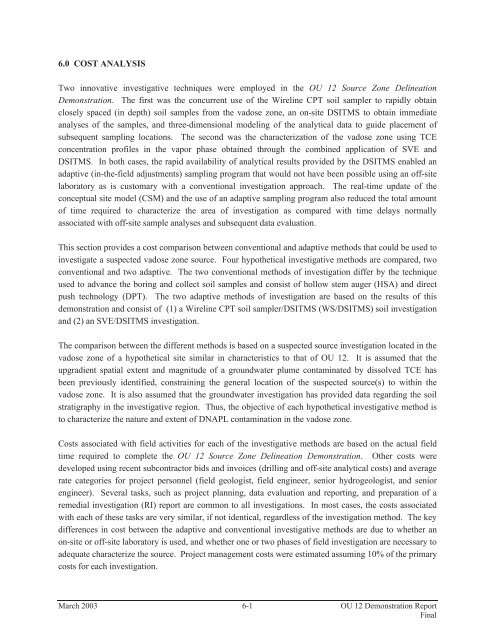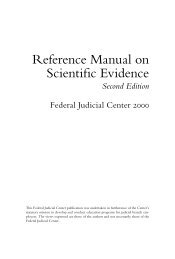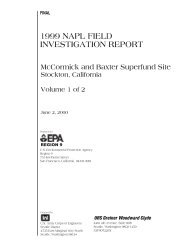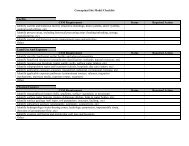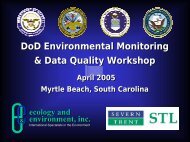Source Zone Delineation Demonstration Report - Triad Resource ...
Source Zone Delineation Demonstration Report - Triad Resource ...
Source Zone Delineation Demonstration Report - Triad Resource ...
You also want an ePaper? Increase the reach of your titles
YUMPU automatically turns print PDFs into web optimized ePapers that Google loves.
6.0 COST ANALYSISTwo innovative investigative techniques were employed in the OU 12 <strong>Source</strong> <strong>Zone</strong> <strong>Delineation</strong><strong>Demonstration</strong>. The first was the concurrent use of the Wireline CPT soil sampler to rapidly obtainclosely spaced (in depth) soil samples from the vadose zone, an on-site DSITMS to obtain immediateanalyses of the samples, and three-dimensional modeling of the analytical data to guide placement ofsubsequent sampling locations. The second was the characterization of the vadose zone using TCEconcentration profiles in the vapor phase obtained through the combined application of SVE andDSITMS. In both cases, the rapid availability of analytical results provided by the DSITMS enabled anadaptive (in-the-field adjustments) sampling program that would not have been possible using an off-sitelaboratory as is customary with a conventional investigation approach. The real-time update of theconceptual site model (CSM) and the use of an adaptive sampling program also reduced the total amountof time required to characterize the area of investigation as compared with time delays normallyassociated with off-site sample analyses and subsequent data evaluation.This section provides a cost comparison between conventional and adaptive methods that could be used toinvestigate a suspected vadose zone source. Four hypothetical investigative methods are compared, twoconventional and two adaptive. The two conventional methods of investigation differ by the techniqueused to advance the boring and collect soil samples and consist of hollow stem auger (HSA) and directpush technology (DPT). The two adaptive methods of investigation are based on the results of thisdemonstration and consist of (1) a Wireline CPT soil sampler/DSITMS (WS/DSITMS) soil investigationand (2) an SVE/DSITMS investigation.The comparison between the different methods is based on a suspected source investigation located in thevadose zone of a hypothetical site similar in characteristics to that of OU 12. It is assumed that theupgradient spatial extent and magnitude of a groundwater plume contaminated by dissolved TCE hasbeen previously identified, constraining the general location of the suspected source(s) to within thevadose zone. It is also assumed that the groundwater investigation has provided data regarding the soilstratigraphy in the investigative region. Thus, the objective of each hypothetical investigative method isto characterize the nature and extent of DNAPL contamination in the vadose zone.Costs associated with field activities for each of the investigative methods are based on the actual fieldtime required to complete the OU 12 <strong>Source</strong> <strong>Zone</strong> <strong>Delineation</strong> <strong>Demonstration</strong>. Other costs weredeveloped using recent subcontractor bids and invoices (drilling and off-site analytical costs) and averagerate categories for project personnel (field geologist, field engineer, senior hydrogeologist, and seniorengineer). Several tasks, such as project planning, data evaluation and reporting, and preparation of aremedial investigation (RI) report are common to all investigations. In most cases, the costs associatedwith each of these tasks are very similar, if not identical, regardless of the investigation method. The keydifferences in cost between the adaptive and conventional investigative methods are due to whether anon-site or off-site laboratory is used, and whether one or two phases of field investigation are necessary toadequate characterize the source. Project management costs were estimated assuming 10% of the primarycosts for each investigation.March 2003 6-1 OU 12 <strong>Demonstration</strong> <strong>Report</strong>Final


